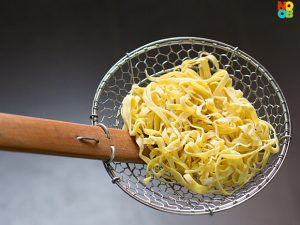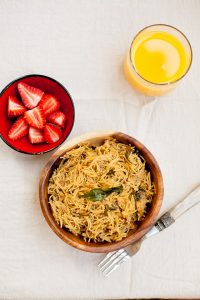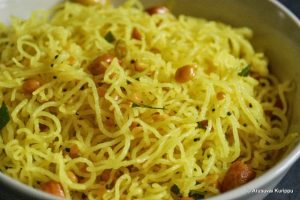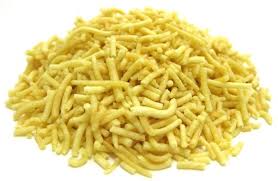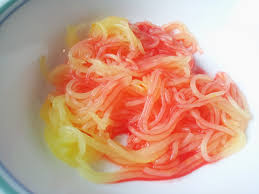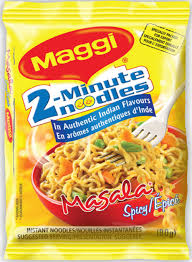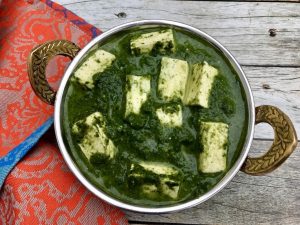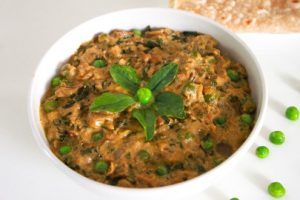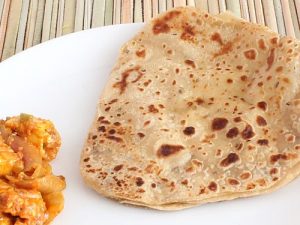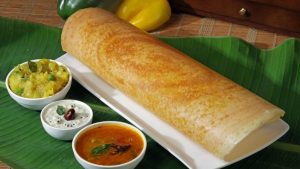The Historical Role of the Noodle in Indian Food Culture
By Vaishnav Shetty
Introduction
Food and culture historians have consistently exposed the way that the noodle reflects Chinese and Italian cultural values and traditions. However, while these two nations may be the first nations that come to mind whenever the noodle as an aspect of culture is brought up, there are many other countries around the world that have integrated the noodle in their own way. Indian food culture is often associated with various curries and rotis, but their proximity to China and historical relationships with various European nations have meant that the noodle found its way into the country during the nation’s early history. An interesting avenue for exploration is the extent of this influence, specifically considering the role that the noodle plays in Indian society and culture. This will allow for an assessment of the noodle across three specific time frames, namely the point when which the noodle was first introduced to India, the way that the noodle successfully found itself integrated into Indian food culture, and the space that it currently occupies in contemporary India society. To conduct this analysis, this essay will analyse various historical texts and sources that explore India’s unique relationship with noodles, including those that reference Indian-specific noodles like seviyan, sevai, sev, and falooda to ensure that the breadth of the Indian noodle experience is taken into consideration. Ultimately, this analysis of the Indian noodle across three different time frames ensures that the question of what place the noodle originally and currently occupies in Indian society can be adequately answered.
Historical Introduction of the Noodle to India
The question of when noodles were first introduced to either Indian or Chinese society and the debate about which nation managed to come up with the idea first is one that people fail to agree upon. Constant arguments for either side have been somewhat mitigated by the possibility that both nations managed to come up with the idea on their own. However, one important fact that both sides agree on when discussing the potential introduction and migration of noodles between food cultures is that their consumption well predates Marco Polo’s original travels along the Silk Road. Much like the case for China and Italy, various sources note that noodles have existed in Indian food culture for an extremely long time. Specifically, food historians point o the fact that “finger millet or ragi is one of the anciet millets in India (2300 BC).” (Shobana et al., 2) Whether this food product qualifies as noodles is a discussion that some people may be divided on, but the fact that scientists and food producers in India utilize the same finger millet that they were using in 2300 BC for the creation of food products like noodles, vermicelli, and other pasta-type products (Shobana et al., 16) contribute heavily to the argument for their inclusion. The fact that India has had noodles and its associated products in their food culture for well over 4000 years is extremely telling. As a result of this extremely early historical introduction of the noodle, one can expect it to have successfully penetrated Indian society and its storied food traditions. This idea is reinforced by the way that the noodle is discussed in common publications of this day, with yoga guru Baba Ramdev discussing how “noodles are very much Indian […] they are integral to the cuisine of many of our North-eastern states.” (Kumar, 22) However, even though the noodle had over 4000 years to complete this process of integration into Indian food culture, the food still needed to prove its worth to Indian society as worthy of acceptance. Highlighting the various characteristics and aspects of noodle tradition made it fit into the Indian community is the second important temporal point of discussion and exploration that will allow for a more robust understanding of its place in Indian society.
Integration of the Noodle into Indian Food Culture
The process of integration into a certain culture within a society often requires that the values and beliefs associated with a certain food line up with the values that the people of that society already hold dear. This commonality between the food and the people that consume it ensures that the dish cements its place in their minds and functions as a means of developing experiences that add to the historical food canon. Noodles established themselves pretty early on in both Chinese and Italian society as a means of showing gratitude, love, and respect, especially towards close friends, spouses, or other family members. Their consumption represented the establishment and strengthening of a communal bond, something that resonated with Indian sentiments about loyalty to family and the ideas of religious acceptance that are a significant part of Hinduism. Additionally, noodles adhere to the Chinese food tenet of balance in the meals that people consume, representing a starchy base that could act as a balancing factor for other more adventurous ingredients that the chef might choose to prepare. Additionally, noodles and their many varied shapes and forms coincided with the Italian emphasis on the consumption of fresh ingredients that accentuated specific regional conditions and the various fresh ingredients native to them. Both of these characteristics fall under the umbrella of general health benefits unique to the noodle, which the Indian community greatly valued after the noodle was introduced into their diet. These health benefits ensured continued consumption of the noodle by members of the Indian population and helped cement its place as a regular feature in the society’s cuisine.
Communal Nature of the Noodle
Research into the traditional role that the Indian joint family plays within Indian society highlights the importance of adhering to collectivist beliefs, social cohesion, and interdependence upon each other (Chadda & Deb, S299). This means that the Indian individual believes in the greater importance of the group over the individual and thus utilizes the close bonds that they form with their family and close friends to perpetuate these beliefs. While the importance of these specific beliefs may have been slowly eroding in the recent years, one cannot deny that in the time period immediately following the introduction of the noodle into India, collectivism would have been a commonly-held cultural and societal belief. The noodle is often described as a dish that represented a large amount of love and respect between the individual serving the dish and the individual receiving it. Chinese family ceremonies and traditions, especially those associated with communicating to the spirit world or ensuring familial health, would never be complete without a noodle dish to punctuate the proceedings. Furthermore, family gatherings and labours of love by Italian families can often be tied to the extensive amount of work that pasta preparation demands. Indian cultural histories about noodles often point to a similar mindset being present during the consumption of traditional noodle dishes. Most notably, the communal aspect of this dish often allowed for the formation of connections that transcended the distinct differences amongst the people that exist in India. Datta’s narratives about life in a Delhi squatter settlement titled “Mongrel City” recounts the way that “during Eid, Abeeda would prepare seviyan and meat and organise a small eating place outside her home.” (Datta, 746) When considering this simple act of preparing a vermicelli dish for the larger community that Abeeda finds herself in, one must make note of the extreme poverty that often characterizes these slums and squatter settlements in the fringes of India’s major cities. Even more astounding is the fact that the constituents of the gathering outside Abeeda’s home would be made up of her neighbours hailing from all different religious background, including Hindus and Sikhs. Datta ultimately observed that the collective and communal nature of the festive celebration, with the noodle dish in the centre of it all, “produced a new kind of relationship between Abeeda and her neighbours who came from different castes, religions, and ethnicities into he squatter settlement in Delhi.” (Datta, 746) While this may have been a singular memory taken from a single narrative tale about a specific community in one city of India, one can expect this exact scene to have been mirrored all across the country in the time following the introduction of the noodle into Indian cuisine. This new type of relationship that the noodle helped nurture would translate into countless new experiences for the people of India. Furthermore, the values that the noodle perpetuated would perfectly coincide with the nation’s adherence to collectivist ideology, further cementing the importance of the new relationships and experiences that the noodle helped form. With such a strong and positive impact on the community as a whole, one cannot help but understand how the noodle’s communal nature allowed the food to successfully integrate into Indian food culture.
Health Benefits of the Noodle to the Indian Diet
The parallels that existed between the noodle’s cultural meanings and those that already characterized the Indian community helped ensure that the experiences and values formed by noodle eaters were both strong and positive. This meant that people and the communities that they made up would seek out these noodles in their future meals. However, the supplemental health benefits that these noodles had to the Indian diet was what ensured that these positive emotions tied to the specific food would not erode over time. Repeated consumption would not create food health issues that could overwrite cultural acceptance that shared noodle experiences would have formed, causing the noodle to become a natural and irremovable food in Indian cuisine. The very first proto-noodle that existed in the Indian food culture was the finger millet. An interesting note that historical consumers of this food and the noodles that would be later made with it emphasize the fact that finger millet and the products that can be made from it possess a lower glycaemic index than their wheat counterparts (Shobana et al., 29). The noodles that would ultimately come to be made of this millet was the healthier option over wheat rotis that was the nation’s original starchy staple. Additionally, researchers found that “consumption of millets reduces risk of heart disease, protects from diabetes, improves digestive system, lowers the risk of cancer, increases immunity in respiratory health, and is protective against several degenerative diseases such as metabolic syndrome and Parkinson’s disease.” (Kavitha et al., 3167) Logical assessments of the food’s integration into Indian food culture following its introduction in the form of finger millet point to the added value that such a healthy food item provided from the Indian noodle consumer. The healthier nature of this alternative and its role in promoting acceptance amongst the Indian community has several parallels to the way that the Chinese believed in the balancing nature of the noodle in their dishes as well as the Italian desire for freshness in their food. Ultimately, the health benefits that the noodle provided to the Indian diet served to pave the way for an easier integration process and reduce the likelihood that the noodle would be phased out from Indian food culture at a later date.
Contemporary Role of the Noodle in India
The contemporary role that the noodle plays in Indian society represents the third and final temporal sphere that this historical exploration will cover, allowing for an analysis of the transition from food’s introduction to the role it has within the community now. As was noted earlier, Indian societal values have begun to change in modern times. Specifically, the nation’s adherence to collectivist philosophies have slowly begun to diminish. Some analysts point to the influence of globalization and the introduction of Western ideology towards this shift in perspective. However, regardless of where this influence is sourced from, the impact that this shift in cultural values must have significant implications for the noodle because of the latter’s status as a communal food product. Despite the potential removal of the noodle from Indian food culture because of this potential disconnect between the new Indian social consciousness and what the noodle stands for, analysis of contemporary noodle consumption in India has identified the food’s resilience and adaptability. While traditional noodle dishes like sev, seviyan, and falooda remain an important part of what people eat during celebrations and ceremonies, a new type of noodle has made its way into the forefront of Indian food culture. This new noodle product is one that has been packaged, positioned, and marketed to accompany the cultural shift that is currently taking place in India. This dynamic adaptability ensures that the noodle maintains a role in contemporary Indian society despite the shifting values and beliefs of the community during this time.
Maggi as a Cultural Phenomenon
Since the noodle’s introduction into Indian food culture over 4000 years ago, it has manifested and been consumed in a variety of different ways. These variations on the noodle owe themselves to specific regional differences that characterize the communities and places consuming the noodle as well as shifts in the social and cultural beliefs held by the community. The latter is one that is playing an extremely important role in the widespread acceptance of a new kind of noodle into the Indian food canon, closely tied to the nation’s shift away from the collectivist principles that defined its historical past. Maggi noodles are instant noodles sold by Swiss transnational food company Nestlé and have cemented themselves as the sole market leader in India for the consumption of this food product, commanding 42% of retail value share in the last year (Euromonitor). Furthermore, while retail sales figures may help outline just how large a cultural phenomenon Maggi is in India, this does not compare to the cultural experiences and histories that Indians from all walks of life have developed with the brand. Specifically, researchers note the way that “the product [Maggi] penetrated all possible layers of the consumer population of India” (Sinha et al., 81), showing the perpetuation of the noodles’ cultural ability to transcend boundaries of race, caste, and religion. However, the way that Maggi is consumed by the Indian population is one that has slowly done away with the communal aspect that used to define noodle meals, instead relegating this to specific family celebrations and ceremonies that are associated with more traditional noodles like seviyan and falooda. Instead, Maggi is representative of the individualistic influences that the process of globalization has brought into the nation, as opposed to the collectivist philosophies that characterize the nation’s past. Maggi’s major selling points are its wide variety of flavours to be chosen from, the idea of being able to consume Maggi “your way” and being extremely convenient (Agarwal). All of these contribute to the brand’s popularity and ability to “register a regular top-of-the-mind recall among the upwardly mobile middle-class consumers.” (Sinha et al., 81) The adaptability of the noodle to the new cultural beliefs that have come to characterize contemporary India allowed for the food to maintain its significant place in the nation’s food canon, albeit in a different form to traditional Indian noodles.
Conclusion
A complete historical analysis of the role of noodles in Indian society requires an assessment of three important time periods, namely: the noodles point of introduction over 4000 years ago, the integrative period where the noodle slowly became accepted as a part of Indian cuisine, and a contemporary analysis that highlights the noodle’s ability to transition alongside shifts in cultural values and beliefs. The finger millet proto-noodle has long been a part of Indian food culture, hearkening back to 2300 BC. This represents the earliest known point of noodle existence in India, potentially brought about by historical migrations through either trade or war by neighbouring nations. However, this long history with the noodle did not guarantee the food’s acceptance by the nation’s inhabitants. Instead, the noodle had to undergo an integrative process that required parallels between Indian collectivist philosophies and the noodle’s communal values. The ability of the noodle to bring separate communities together resonated with the Indian people which allowed for the formation of strong, positive memories throughout its history in India. Additionally, the noodle’s positive health contributions supplemented these cultural connections and ensured people remained willing to eat the food. However, as Indian society progressed through the years, significant changes to the nation’s cultural makeup caused shifts in the beliefs and values that the people held. The noodles’ adaptable nature ensured that the food would also make necessary adjustments to accommodate this shift, evident in the significant place that Maggi instant noodles occupies in contemporary Indian society. While this specific variety of noodle maintains a connection to Indian noodles of the past that value connection across cultures, their different form is testament to the shift away from collectivism that contemporary India is currently experiencing. Ultimately, the historical role that the noodle plays in Indian society is one of a loved food staple with a long history in the nation but is also capable of adapting to the nation’s cultural shifts over time.
Works Cited
Agarwal, N. “11 Reasons why Maggi is the Best Comfort Food!” The Times of India. September 18, 2014. Retrieved from https://timesofindia.indiatimes.com/lifestyle/11-Reasons-Why-Maggi-Is-The-Best-Comfort-Food/quickstirshow/42706038.cms.
Chadda, R. K., and K. S. Deb. “Indian family systems, collectivistic society and psychotherapy.” Indian Journal of Psychiatry 55.Suppl 2 (2013): S299-309.
Datta, A. “‘Mongrel City’: Cosmopolitan Neighbourliness in a Delhi Squatter Settlement.” Antipode 44.3 (2012): 745-763.
Euromonitor International. “Rice Pasta and Noodles in India.” Retrieved from http://www.euromonitor.com/rice-pasta-and-noodles-in-india/report.
Kavitha, V., G. Sindumathi, and K. Chandran. “Small Millets-Food for the Poor or Elite? An Online Market Study in Coimbatore City of Tamil Nadu, India.” International Journal of Current Microbiology and Applied Sciences 6.11 (2017): 3167-3171.
Kumar, S. S. “Sustainability Through Extension “A Case Study of Patanjali Ayurved Pvt Ltd. Baba Ramdev-Jack of All Trades”.” Episteme 5.1 (2016): 14-27.
Sahadeo, M. V. Standardisation of Falooda. Doctoral Dissertation MPKV, 2015. 1-71.
Patel, S. K. Optimization and Formulation of Nutri-Rich Snack Food (Sev). Doctoral Dissertation JNKVV, 2016. 1-41.
Shobana, S., et al. “Finger Millet (Ragi, Eleusine coracana L.): A Review of its Nutritional Properties, Processing, and Plausible Health Benefits.” Advances in Food and Nutrition Research 69 (2013): 1-39.
Sinha, S., D. Sinha, and G. Gupta. “Maggi as a Youth Icon in India: A Case of Cultural Branding.” Proceedings of ICRBS 2015 (2015): 81-84.

